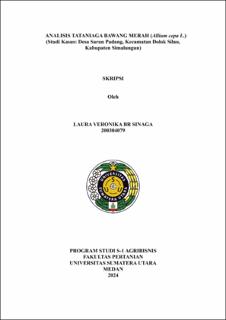| dc.contributor.advisor | Sihombing, Luhut | |
| dc.contributor.author | Sinaga, Laura Veronika Br | |
| dc.date.accessioned | 2024-12-16T10:11:51Z | |
| dc.date.available | 2024-12-16T10:11:51Z | |
| dc.date.issued | 2024 | |
| dc.identifier.uri | https://repositori.usu.ac.id/handle/123456789/99463 | |
| dc.description.abstract | Shallots are one of the horticultural crops that are required continuously. Saran Padang Village is one of the centers of shallot production. However, there is a problem that there is a fairly high price difference at the farm level and at the consumer level. From these problems, this study aims to determine the amount of production costs of shallot farming, to determine the channel form and function of shallot commodity trade, and to determine the level of efficiency of shallot commodity trade. The research data were collected by observation and interviews using questionnaires with a total of 43 farmers and 12 traders. The method used in this research is descriptive qualitative and quantitative analysis, qualitative methods are used to look at the form of trade channels and trade functions and quantitative methods are used to see production costs, the level of trade efficiency, and farmer’s share of shallots using Microsoft Excel software. The results of this study indicate that the total production cost of shallot farming is Rp.9,319,547/rante. Onion trading in Saran Padang Village has 4 patterns of trading channels, channel I (Farmers - Level 1 Collecting Traders - Level 2 Collecting Traders - Wholesalers - Retailers - Consumers), channel II (Farmers - Level 1 Collecting Traders - Level 2 Collecting Traders - Wholesalers - Consumers), channel III (Farmers - Level 1 Collecting Traders - Level 2 Collecting Traders - Retailers - Consumers), and channel IV (Farmers - Level 1 Collecting Traders - Retailers - Consumers). The shallot commerce channel is classified as efficient and the most efficient channel is commerce channel IV because it has the highest efficiency value. The farmers' share in the four shallot trade channels is classified as efficient because the value in each channel is greater than 50%. | en_US |
| dc.language.iso | id | en_US |
| dc.publisher | Universitas Sumatera Utara | en_US |
| dc.subject | Shallots | en_US |
| dc.subject | Production Costs | en_US |
| dc.subject | Channels | en_US |
| dc.subject | Commerce | en_US |
| dc.subject | Efficiency | en_US |
| dc.subject | Farmer’s share | en_US |
| dc.title | Analisis Tataniaga Bawang Merah (Allium cepa L.) (Studi Kasus Desa Saran Padang, Kecamatan Dolok Silau, Kabupaten Simalungun) | en_US |
| dc.title.alternative | Analysis of Shallots (Allium Cepa. L) Commerce (Case Study: Saran Padang Village, Dolok Silau District, Simalungun Regency) | en_US |
| dc.type | Thesis | en_US |
| dc.identifier.nim | NIM200304079 | |
| dc.identifier.nidn | NIDN0008106504 | |
| dc.identifier.kodeprodi | KODEPRODI54201#Agribisnis | |
| dc.description.pages | 102 Pages | en_US |
| dc.description.type | Skripsi Sarjana | en_US |
| dc.subject.sdgs | SDGs 8. Decent Work And Economic Growth | en_US |


